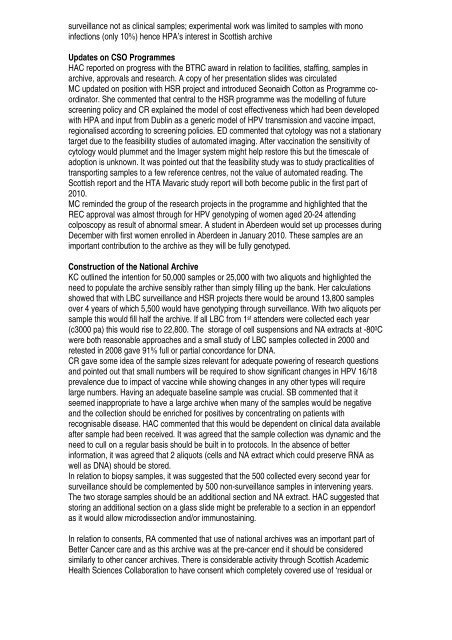Scottish HPV Investigators' Network (SHINe) - University of Edinburgh
Scottish HPV Investigators' Network (SHINe) - University of Edinburgh
Scottish HPV Investigators' Network (SHINe) - University of Edinburgh
Create successful ePaper yourself
Turn your PDF publications into a flip-book with our unique Google optimized e-Paper software.
surveillance not as clinical samples; experimental work was limited to samples with mono<br />
infections (only 10%) hence HPA’s interest in <strong>Scottish</strong> archive<br />
Updates on CSO Programmes<br />
HAC reported on progress with the BTRC award in relation to facilities, staffing, samples in<br />
archive, approvals and research. A copy <strong>of</strong> her presentation slides was circulated<br />
MC updated on position with HSR project and introduced Seonaidh Cotton as Programme coordinator.<br />
She commented that central to the HSR programme was the modelling <strong>of</strong> future<br />
screening policy and CR explained the model <strong>of</strong> cost effectiveness which had been developed<br />
with HPA and input from Dublin as a generic model <strong>of</strong> <strong>HPV</strong> transmission and vaccine impact,<br />
regionalised according to screening policies. ED commented that cytology was not a stationary<br />
target due to the feasibility studies <strong>of</strong> automated imaging. After vaccination the sensitivity <strong>of</strong><br />
cytology would plummet and the Imager system might help restore this but the timescale <strong>of</strong><br />
adoption is unknown. It was pointed out that the feasibility study was to study practicalities <strong>of</strong><br />
transporting samples to a few reference centres, not the value <strong>of</strong> automated reading. The<br />
<strong>Scottish</strong> report and the HTA Mavaric study report will both become public in the first part <strong>of</strong><br />
2010.<br />
MC reminded the group <strong>of</strong> the research projects in the programme and highlighted that the<br />
REC approval was almost through for <strong>HPV</strong> genotyping <strong>of</strong> women aged 20-24 attending<br />
colposcopy as result <strong>of</strong> abnormal smear. A student in Aberdeen would set up processes during<br />
December with first women enrolled in Aberdeen in January 2010. These samples are an<br />
important contribution to the archive as they will be fully genotyped.<br />
Construction <strong>of</strong> the National Archive<br />
KC outlined the intention for 50,000 samples or 25,000 with two aliquots and highlighted the<br />
need to populate the archive sensibly rather than simply filling up the bank. Her calculations<br />
showed that with LBC surveillance and HSR projects there would be around 13,800 samples<br />
over 4 years <strong>of</strong> which 5,500 would have genotyping through surveillance. With two aliquots per<br />
sample this would fill half the archive. If all LBC from 1 st attenders were collected each year<br />
(c3000 pa) this would rise to 22,800. The storage <strong>of</strong> cell suspensions and NA extracts at -80 0 C<br />
were both reasonable approaches and a small study <strong>of</strong> LBC samples collected in 2000 and<br />
retested in 2008 gave 91% full or partial concordance for DNA.<br />
CR gave some idea <strong>of</strong> the sample sizes relevant for adequate powering <strong>of</strong> research questions<br />
and pointed out that small numbers will be required to show significant changes in <strong>HPV</strong> 16/18<br />
prevalence due to impact <strong>of</strong> vaccine while showing changes in any other types will require<br />
large numbers. Having an adequate baseline sample was crucial. SB commented that it<br />
seemed inappropriate to have a large archive when many <strong>of</strong> the samples would be negative<br />
and the collection should be enriched for positives by concentrating on patients with<br />
recognisable disease. HAC commented that this would be dependent on clinical data available<br />
after sample had been received. It was agreed that the sample collection was dynamic and the<br />
need to cull on a regular basis should be built in to protocols. In the absence <strong>of</strong> better<br />
information, it was agreed that 2 aliquots (cells and NA extract which could preserve RNA as<br />
well as DNA) should be stored.<br />
In relation to biopsy samples, it was suggested that the 500 collected every second year for<br />
surveillance should be complemented by 500 non-surveillance samples in intervening years.<br />
The two storage samples should be an additional section and NA extract. HAC suggested that<br />
storing an additional section on a glass slide might be preferable to a section in an eppendorf<br />
as it would allow microdissection and/or immunostaining.<br />
In relation to consents, RA commented that use <strong>of</strong> national archives was an important part <strong>of</strong><br />
Better Cancer care and as this archive was at the pre-cancer end it should be considered<br />
similarly to other cancer archives. There is considerable activity through <strong>Scottish</strong> Academic<br />
Health Sciences Collaboration to have consent which completely covered use <strong>of</strong> ‘residual or


